|

 Sumeria:
(Mesopotamia, 'The Land Between Two Rivers')
Sumeria:
(Mesopotamia, 'The Land Between Two Rivers')

The Sumerian
civilisation developed on the Persian Gulf, growing to strength at around
4 - 3,000 B.C. The 'Plain of
the Land of Shinar' is the territory which after 2,000 B.C. became called
Babylon. The Greeks named
the region Mesopotamia (The land between two rivers), most of which lies
in the modern state of Iraq.
Quick-links.
(Map of Sumeria)
| The
Sumerians: (Chronology). |
The exact origins of the
Sumerians are unknown. They entered Mesopotamia c. 4,000 B.C.
The original homeland of the Sumerians is
unknown. It is believed that they came from the east
(2),
but whether by sea or from the highlands is unknown. We know that they
are not local people because their language belongs to an isolated
language group. During the 5th millennium B.C. a people
known as the Ubaidians established settlements in the region
later known as Sumer (Mesopotamia)
(2) It has
been noticed that there
are very clear similarities between the Ubaid artwork, and that
of of 'Old Europe' Vinca Culture
which flourished c. 6,000 - 3,500 BC.
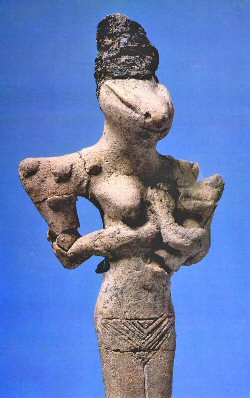

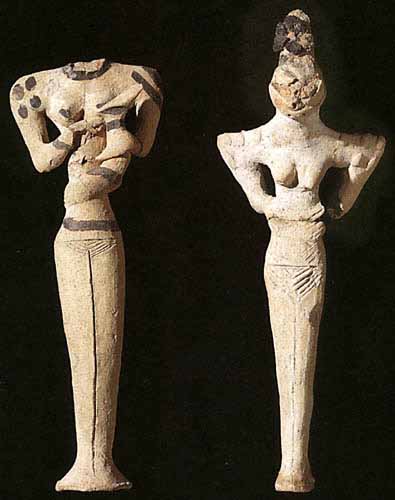
The Ubaid 'Annunaki' c.4,000 B.C.
At
around 3,250 BC, another people migrated from its homeland, located
probably northeast of Mesopotamia, and began to intermarry with the
native population. The newcomers, who became known as Sumerians, spoke
an agglutinative language unrelated apparently to any other known
language.
(2)
Al Ubaid Elongated Skulls:
The earliest significant record of skull elongation comes in the
form of the pottery representations of the Gods
from the 5th millennium B.C. The
Al-Ubaid culture proceeded the Sumerian culture was a people
known as the Ubaidians who established settlements in the region
later known as Sumer (Mesopotamia)
(7) It has
been noticed that there
are very strong similarities between the Ubaid artwork, and that
of of 'Old Europe' Vinca Culture
which flourished c. 6,000 - 3,500 BC.
John Marshall�s �Mohenjo-Daro
and the Indus Civilization� as well as �Anthropology�
(by Ram Nath Sharma, Rajendra Kumar Sharma) in addition to Al-Ubaid
burials, wrote that cranial deformation features were also seen of
skulls of Kish; Ur of Mesopotamia; Additanallur in Madras; Veddahs
of Ceylon (Sri Lanka); Naga of Calcutta; jar burials of Harappa;
Mediterranean; Nal in Baluchistan; Sialkot in Punjab; and Bayana
(Aryan skulls) in Uttar Pradesh.
(7)
Marshall (8)
makes a comparison between the elongated Al Ubaid
skulls and those found from the Indus Valley Civilisation, noting
that the Al Ubaid skulls are 'Not as elongated as those from
Mohenjo-Daro'.
(More
about Elongated Skulls and Cranial Deformation)



Sumerian 'Priests' or 'Votive
Statues' c. 3,000 - 2,500 BC.
By
3,100 B.C. the population of Sumer had increased to the point where
people were living in cities. (2)
The first Sumerian ruler of
historical record, Etana, king of Kish (flourished about 2,800 BC), was
described in a document written centuries later as the "man who
stabilized all the lands."
(2)
The early dynastic period of Sumer
covers the part of the third millennium from 2,800 to 2,400 BC, and ends
with the conquest of Sumer by a Semitic king of the north, Sargon I of
Akkad. (1)
The Sumerian king list:
(In the following translation,
mss. are referred to by the sigla used by Vincente 1995; from those
listed there, mss. Fi, Go, P6, and WB 62 were not used; if not specified
by a note, numerical data come from ms. WB.)
'After the kingship
descended from heaven, the kingship was in Eridug.
In Eridug, Alulim
became king; he ruled for 28,800 years. Alaljar
ruled for 36,000 years. 2 kings; they ruled for 64,800 years. Then
Eridug fell and the kingship was taken to
Bad-tibira. In Bad-tibira,
En-men-lu-ana ruled for 43,200 years.
En-men-gal-ana ruled for 28,800 years.
Dumuzid, the shepherd, ruled for 36,000 years.
3 kings; they ruled for 108,000 years. Then Bad-tibira
fell (?) and the kingship was taken to Larag.
In Larag, En-sipad-zid-ana
ruled for 28,800 years. 1 king; he ruled for 28,800 years. Then
Larag fell (?) and the kingship was taken to
Zimbir. In Zimbir,
En-men-dur-ana became king; he ruled for
21,000 years. 1 king; he ruled for 21,000 years. Then
Zimbir fell (?) and the kingship was taken to
Curuppag. In Curuppag,
Ubara-Tutu became king; he ruled for
18,600 years. 1 king; he ruled for 18,600 years. In 5 cities 8 kings;
they ruled for 241,200 years. Then the flood swept over'.
Excavations in Iraq have revealed evidence of localized
flooding at Shuruppak (modern Tell Fara, Iraq) and various other
Sumerian cities. A layer of riverine sediments, radiocarbon
dated to ca. 2,900 B.C., interrupts the continuity of
settlement, extending as far north as the city of Kish.
Polychrome pottery from the Jemdet Nasr period (3,000-2,900 BCE)
was discovered immediately below the Shuruppak flood stratum.
(3)
|
Writing
(Cuneiform)
- The Sumerian writing known as cuneiform is often (mistakenly)
cited as the oldest writing in the world. It was achieved by
pressing a 'stylus' made of reed or wood into soft clay tablets. The
first signs were pictographic, later improved upon by the
Babylonians, who created a syllabic script.
A strong link
has been shown to exist between the scripts of the 'Old Europe'
Vinca culture and the Sumerians. It was long assumed that the
Sumerians were the originators of writing, but recent archaeology
has shown that the Vinca existed c. 6,000 - 3,500 BC, with evidence
of the Vinca 'proto' script from as early as 5,500 BC. This evidence
clearly suggests that the Vinca were the originators of script, and
not the Sumerians, to whom they apparently passed it on during their
mass migration following the collapse of their 2,000 year old
civilisation.
(More
about the Vinca Culture)

Associated
with writing is the development of cylinder-seals, which were
also a Sumerian invention.
The first written documents, from around 3,500 BC, are receipts
and lists of items.
(1)
Amongst the
thousands of cuneiform clay tablets discovered, there are three
major Sumerian texts left to us; The Epic of Creation (Enuma
Elish), The Epic of the Flood and The Epic of Gilgamesh.
The discovery
of both Sumerian and Indus valley seals demonstrates a level of
communication between the two great cultures. Both of which
disappeared overnight at around the same time.
(More
about the Indus Valley Culture)
Astronomy: The
Sumerians are amongst the first people to leave sophisticated
records of their astronomical observations. Their fascination
with the heavens is apparent in the large number of seals and
cuneiform tablets unearthed of an astronomical nature.
The Sumerians were the first to divide both space and time by
units of six.
The modern division of the year into 12 months, the 24 hours of
each day, the division of hours into 60 minutes and 60 seconds,
and the divisions of the circle/sphere by 360 degrees, each
composed of 60 minutes and 60 seconds of an arc, are all
Sumerian developments. This same division by units of six has
been observed at several of prominent British megaliths.
Aubrey Burl said of it:
'From
Brodgar, where there was once 60
stones, to the Stripple stones with a probable thirty, the builders
may have counted in multiples of six.
Stennes had twelve. The inner and
outer rings at Balfarg have been computed at twenty-four and twelve
respectively. Twenty-four has been suggested for Cairnpappel,
thirty-six for
Arbor Low, and the same number for the devils quoits'. (3)
The Sumerians were also aware of the importance of Pleiades,
showing it in several seals and images
(4).


In addition to being thought of as the seven
great gods gathered together, the morning setting of Pleiades
was used to mark the beginning and end of the
agricultural year.
The Sumerians called the twelve major zodiacal constellations the
'Shiny Herd'.
|
Sumerian |
Translation |
Modern name |
|
GU.AN.NA
MASH.TAB.BA
DUB
UR.GULA
AB.SIN
ZI.BA.AN.NA
GIR.TAB
PA.BIL (Archer)
SUHUR.MASH
GU
SIM.MAH
KU.MAL
|
Heavenly Bull
Twins
Pincers, Tongs
Lion
Her father was Sin
Heavenly Fate
Which claws and cuts
Defender
Goat-Fish
Lord of the waters
Fishes
Field dweller
|
Taurus
Gemini
Cancer
Leo
Virgo
Libra
Scorpio
Sagittarius
Capricorn
Aquarius
Pisces
Aries
|
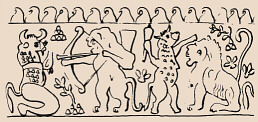
Possible 'Cardinal'
animals. From Susa. c. 3,000 B.C.
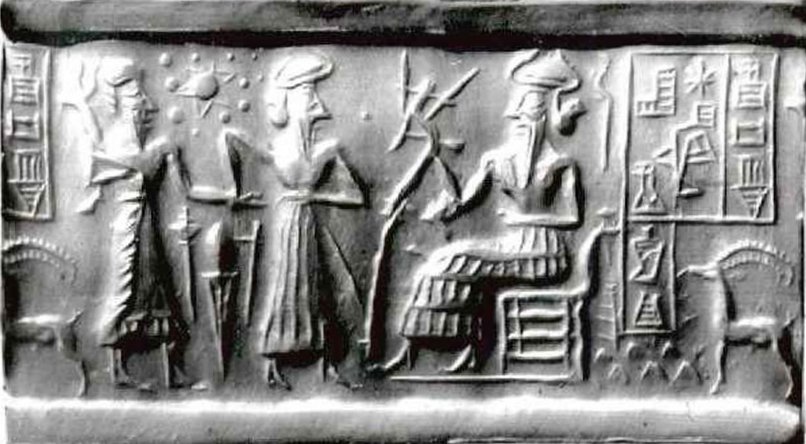
This
cylinder seal
(VA/243 -State Museum, East Berlin),
shows a 'star' with several (eleven) planets
surrounding it. However, as there are no known records of the
Sumerians having knowledge of any more than five planets in our
solar-system the jury's out over what it represents.
(More
about Archaeoastronomy)
Other
Sumerian 'Firsts':
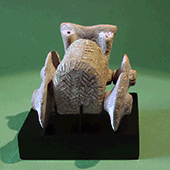
The Wheel: Many
authorities regard the wheel as one of the oldest and most
important
inventions which supposedly originated in ancient Mesopotamia
in the
5th millennium BC ( Ubaid period),
suggested to be originally in the function of
potter's wheels. Near the northern side of the
Caucasus several graves were found, in which since
3,700 BC people had been buried on wagons or carts (both types).
(Ref: Wikipedia.com).
An similar example of the Sumerian wheeled
vehicle (right) but from c. 5,500 BC was recently (2012) discovered
in Mardin, Turkey and is now on display in the Mardin Museum. (Quick-link)

Ziggurat's (Predecessors to Pyramids)
The Ziggurat of Ur, Iraq -
Was a '7 Step-pyramid', and
is officially classified as a 'Solar Temple'.
The similarity in style with
Djoser's step pyramid at Saqqara is too strong to ignore.
Both structures
were built with mud bricks, built in steps, and both are
surrounded by the same relief pattern on the walls (although at
Saqqara this pattern is transposed onto the compound wall rather
than on the pyramid itself as at Ur).
(More about
Ur, Iraq)
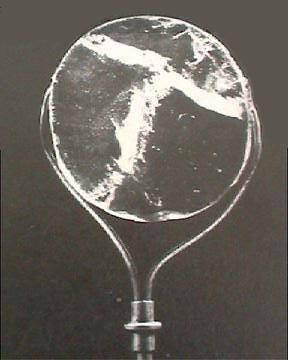
The crystal
�lens� from Nineveh (Kuyunjik, Iraq)
In 1853, Sir David Brewster
(1781-1868) presented a lens to the British Association for the
Advancement of Science that had been found in excavations by
Austen Henry Layard (1817-1894) at Nineveh (Kuyunjik, Iraq). It
had been found in deposits dated around 600 BC and although its
provenance was not in question, doubts were raised about its
function. Whilst it clearly works as a lens, it was thought to
have been used as a decoration in a piece of jewellery.
The first glass was Sumerian.
(1)
(More
about Optics in Prehistory)
Beer Brewing.
Article: The Independent. 22nd March 1997.
Chemical analysis has identified a
6,000-year-old brewery at an archaeological site in what is now
modern Iran. The evidence, which was published recently in the
scientific journal Nature, suggests that fermentation of barley
was first practised in Sumer - southern Babylonia - between 4000
and 3000 BC. The Sumerian civilisation occupied the flood plain
between the lower Tigris and Euphrates rivers, land that is
today mainly shared by Syria and Iraq. One of the oldest
literate civilisations, the Sumerians had a sophisticated system
of agriculture, in which irrigation was used to grow cereal
crops, including barley.
Towards the end of last year,
archaeologists found a jar from the late fourth millennium BC at
Goden Tepe (just inside the border of Iran). It has grooves
containing traces of calcium oxalate, the main component of
'beerstone', a substance that settles on the surfaces of storage
tanks of fermented drinks brewed from barley. The only other
foodstuffs to contain an appreciable amount of oxalates are
spinach and rhubarb, neither of which plays a key part in the
human diet.
The archaeologists working on this ancient
artefact, Rudolph Michel and Patrick McGovern of the University
of Pennsylvania, and Virginia Badler of the University of
Toronto, have concluded that it was used as a vessel for a
fermented barley drink. If this is indeed the case, then they
have stumbled across the earliest record of such brewing in
history.
(Link
to Full article)
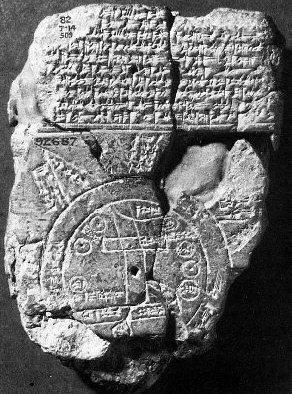
Babylonian map of the
world.
Babylonian "map
of the world" in the British Museum, London was long claimed as
the earliest extant map. The map was composed in Babylonia and
is the only Babylonian map drawn on an international scale. It
is a Neo-Babylonian (Persian Period, circa 500 BCE) copy of an
original dating to the Sargonid Period, circa late eighth or
seventh century BCE. The clay tablet is a drawing and textual
description of the Babylonian cosmos. It is oriented to the
north-west. (It is uncertain whether the accompanying cuneiform
text was composed together with the map.) It is the only known
map of the world dating from the Neo-Babylonian Period. All
other maps have a purely local focus.
(More about the Babylonian
Map of the World)
The Baghdad Batteries:
(AD225-640).
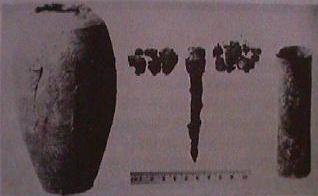 Railway
construction in Baghdad in 1936, uncovered a copper cylinder with a rod of
iron amongst other finds from the Parthian period. In 1938, these were
identified as primitive electric cells by Dr. Wilhelm Konig, then the
director of the Baghdad museum laboratory, who related the discovery to
other similar finds (Iraqi cylinders, rods and asphalt stoppers, all
corroded as if by some acid, and a few slender Iron and Bronze rods found
with them). He concluded that their purpose was for electroplating gold and
Silver jewellery. Railway
construction in Baghdad in 1936, uncovered a copper cylinder with a rod of
iron amongst other finds from the Parthian period. In 1938, these were
identified as primitive electric cells by Dr. Wilhelm Konig, then the
director of the Baghdad museum laboratory, who related the discovery to
other similar finds (Iraqi cylinders, rods and asphalt stoppers, all
corroded as if by some acid, and a few slender Iron and Bronze rods found
with them). He concluded that their purpose was for electroplating gold and
Silver jewellery.
(More about the Baghdad Batteries)
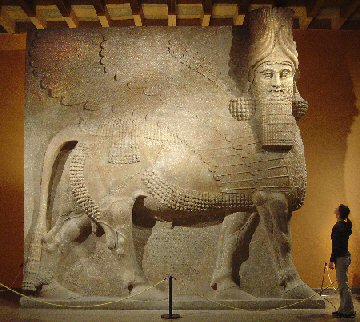
Mesopotamian 'Lamassu' from Khorsabad . (Estimated weight 30-40 Tons).
(Top-50 Stones of all
Time)
| Gilgamesh: From
Europe to the Indus Valley: |
It was long suspected that there was a connection between the early
dynastic Egyptians and the Sumerians. The Knife found at the Royal cemetery in
Abydoss (right), with its depiction of Gilgamesh, is proof enough, but the
following information suggests that the Sumerians were more multicultural than
originally thought.
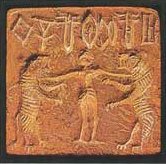
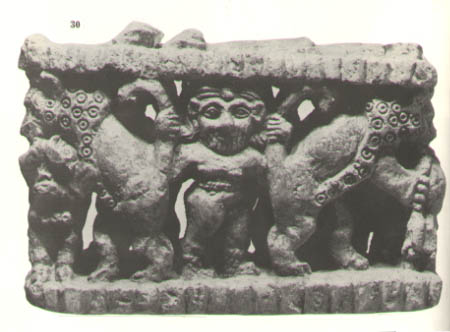

Gilgamesh in
Mohenjo Daro, Indus Valley (left),
Sumeria (centre) and Abydoss, Egypt
(right).
The 'Gilgamesh' figure is an iconic Sumerian
image, found in other prehistoric civilisations such as Early Dynastic
Egypt and the Indus Valley. Curiously enough, the same figure, but with
a woman between the felines is found at other prehistoric
locations such as the Mycenaean, Anatolian and Maltese.
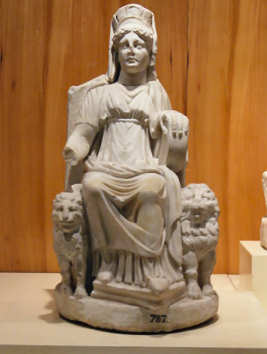
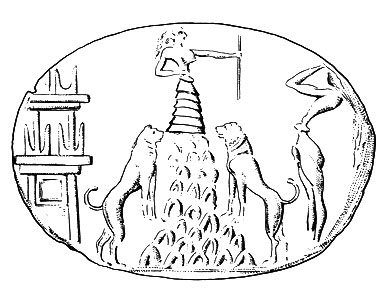

If we go back further into Anatolian prehistory to
Catal hoyuk (8,000 B.C.), for example, we can
also compare the figurine of a large female sitting upon a throne flanked by
either Lions or leopards (right). The Prehistoric European Earth Goddess or Cybele
(left), is also often depicted enthroned with lions as was the
Minoan mountain goddess (centre).
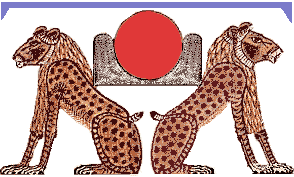
It is perhaps interesting to note, in relation to the prehistoric images of
an Earth-Mother-Goddess with Lions on either side, that the Egyptians used the
symbol of two lions 'Aker' to represent the horizon. In this context, we can see
through these earlier iconic images of a female Earth-Mother-Goddess flanked by
felines, a depiction of the literal Earth itself.
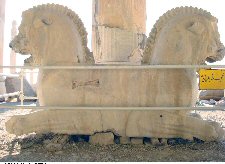


The same symbols were later used as 'guardians' of important cities, temples
etc.
(From left to right - Persepolis, Alaya Huyuk,
Mycenae)
The Indus Valley seals.
(Genesis. Ch.11) -
'And it came to pass, as they journeyed from the
East, that they found a plain in the land of Shinar, and they dwelt
there'...
Archaeologists can use both the trade in seals themselves,
as well as the distances between seals and the corresponding sealings, to trace long-distance trade networks. One such
set of seals were manufactured around 1,900 B.C. on two
important island trading cities in the Persian Gulf - Bahrein and Failaka. These seals were traded all over the
Middle East, and have been found at diverse and distant
locations such as Susa in Iran, Bactria in Afghanistan, Ur
in Iraq, and Lothal on the west coast of India. By 1,750
B.C. Common Style seals are found in locations ranging from
Spain, to Mycenaean Greece, to Marlik near the shores of the
Caspian Sea. These seals were made from faience, a less
expensive material, and used by smaller merchants.
[2]
The first
objects unearthed from Harappa and
Mohenjo-Daro were small
stone seals inscribed with elegant depictions of animals,
including unicorn-like figures, and marked
with Indus script writing which still baffles scholars.
These seals are dated back to 2,500 B. C. Source: North Park
University, Chicago, Illinois.
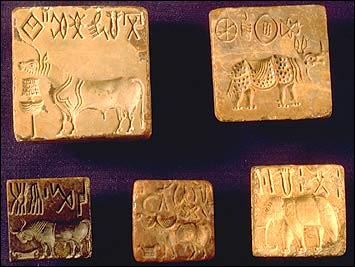 The
first cylinder seals belonged to the
now long dead civilization of the Sumerians,
the inhabitants of Nippur, Lagash, and other cities on the
Euphrates and Tigris rivers in what is now Iraq. They spoke
a strange language -- neither Semitic nor Indo-European, the
family of languages spoken by many later civilizations and
the most current inhabitants of the Middle East. Sumerian
was an tongue, bearing resemblance to such
diverse languages as Turkish, Finnish,
Japanese, and Dravidian. Indeed, it was probably some
version of the latter tongue that was spoken by their
neighbours, the early inhabitants of the Indus river valley.
These Indus valley people developed, soon after the
Sumerians, their own civilization and unique style of seals.
Modern speakers of Dravidian languages are scattered all
over the Indian subcontinent, including remnants in
Afghanistan and a large number of Tamils in southern India. The
first cylinder seals belonged to the
now long dead civilization of the Sumerians,
the inhabitants of Nippur, Lagash, and other cities on the
Euphrates and Tigris rivers in what is now Iraq. They spoke
a strange language -- neither Semitic nor Indo-European, the
family of languages spoken by many later civilizations and
the most current inhabitants of the Middle East. Sumerian
was an tongue, bearing resemblance to such
diverse languages as Turkish, Finnish,
Japanese, and Dravidian. Indeed, it was probably some
version of the latter tongue that was spoken by their
neighbours, the early inhabitants of the Indus river valley.
These Indus valley people developed, soon after the
Sumerians, their own civilization and unique style of seals.
Modern speakers of Dravidian languages are scattered all
over the Indian subcontinent, including remnants in
Afghanistan and a large number of Tamils in southern India.
Seal impressions have been found in the ancient city of Harrapan, in the Indus River valley (modern Pakistan), that
had been made by seals found in Lagash in Sumeria (modern
Iraq). From 3,600 B.C. in Sumer, and a little later in the
Indus Valley, we can find seals made out of a rare
high-quality stone, lapis lazuli. These stones could only
have originated from rather distant and inaccessible mines
in Afghanistan.
(Full list of Indus Valley Symbols)
Early Sumerian Influences in Egypt.
 The Al-Gezeb Knife, Abydoss, Egypt
(right): This knife, with
the Gilgamesh figure carved on one side, was found in the
Pre-Dynastic cemetery at
Abydoss, Egypt. The perfectly knapped flint blade
highlights the high skill levels attained towards the end of the Neolithic
period. The Al-Gezeb Knife, Abydoss, Egypt
(right): This knife, with
the Gilgamesh figure carved on one side, was found in the
Pre-Dynastic cemetery at
Abydoss, Egypt. The perfectly knapped flint blade
highlights the high skill levels attained towards the end of the Neolithic
period.
These earliest
potential reference to Sumerian and Egyptian communication
is the record of a mass immigration of people
called the 'Shepherd Folk' into Egypt from 'The East' at
around the same time as the decline of the Sumerian Empire
and the simultaneous rise of the Egyptian Dynasties. (c.
3,000 B.C.)
The pre-dynastic
Pharaohs of Egypt were Sumerians from about 2780 B.C.[5].
At the time of Sargon (Sargon the Great) Egypt was
referred to as Mizir or Dilmun and his tomb (as a
predynastic Pharaoh) was found at the royal tombs at
Abydos (in Egypt today).
Egyptian hieroglyphs
are a slightly modified conventional form of the Sumerian
diagrammatic picture-writing which came into use during
the rule of Menes and the 1st dynasty pharaohs;
they have the same phonetic values as their parent
picture-signs in the Sumerian.
Menes (Manj of Egyptian legend) (Manis of Mesopotamia)
(Min or Minos of Greek legend) erected Egypt into an
independent kingdom and preserved its independence within
the Mesopotamian empire when he succeeded to the throne
after his father's death; Menes was the prince of Sumeria
and governor of the Sumerian Indus Valley. Menes annexed
and civilized Crete and extended his rule to the Pillars
of Hercules and Britain.
Menes was the son of Sargon (who had a Queen named Lady
Ash), or "Sargon the Great" of
ancient Mesopotamia and Menes and his dynasty referred to
themselves as "Gut"(Goth) (in Indus Valley seals) and
"Bar" or "Par"(Pharaoh) (as referred to in Egyptian
records).
Menes' Egyptian inscriptions were written in Sumerian
script (not the later conventionalized hieroglyphs) and
deciphered to match Menes' Mesopotamian and Elam records
as well as his official seals in the Indus Valley (where
he was a Sumerian governor there until he revolted against
his father (Sargon) and annexed Egypt).
Menes had a son named Narmar or Naram (Naram Enzu) whom he
sent to the Indus colony of Edin as a viceroy.
(More on this
subject)
|
'Buckets', 'Corn'
and the 'Tree of Life'.
A common Mesopotamian theme, found on many
seals, and works of art is the appearance of what appears to be an
image of the 'Tree of Life/knowledge' being harvested (or watered),
by 'Winged people' or occasionally by 'Fish-people' as the cylinder
seal below shows.
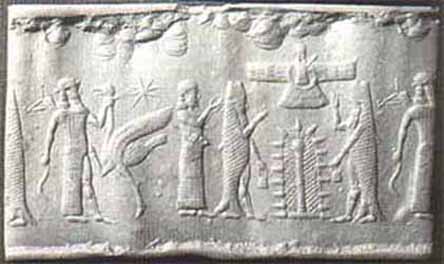
The 'Enuma Elish' epic of creation, describes the 'Half fish God'
Eanna coming from the water following the 'great deluge' to bring
knowledge to the Sumerians.
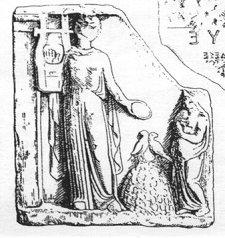
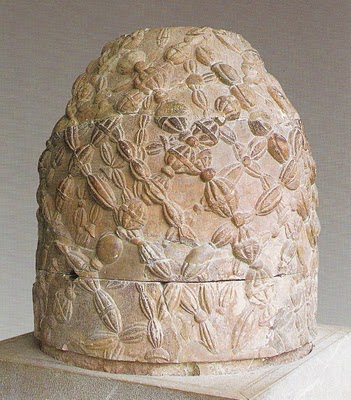
The Sumerian image of the 'tree of life/knowledge' is
reminiscent of the later images of Greek 'Omphalos' or woven 'Navel
Stones' - which in turn originated From
Thebes in Egypt).
The eagle-headed winged protective spirit 'Djinn' shown here is known as
an �Apkallu� spirit.
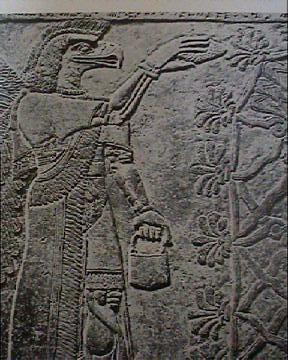
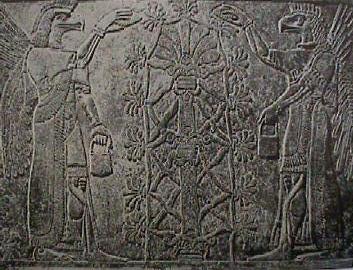

Although it is commonly suggested that these
figures are 'watering' the 'tree of life' , the following images
suggest otherwise.
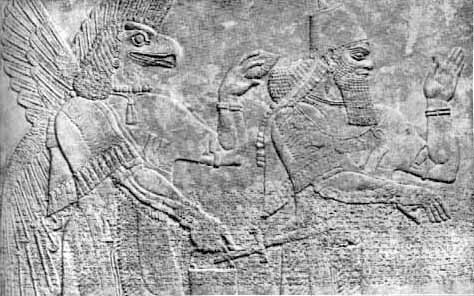
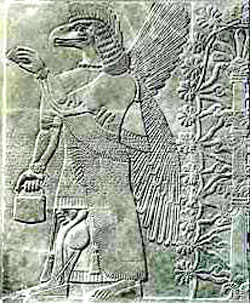
In these images the 'cob' is not 'watering' the 'tree of life'..
suggesting it is being 'harvested' instead.
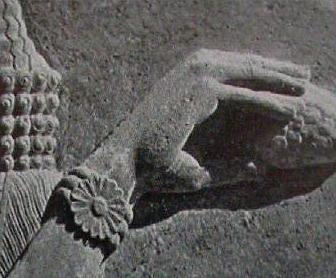
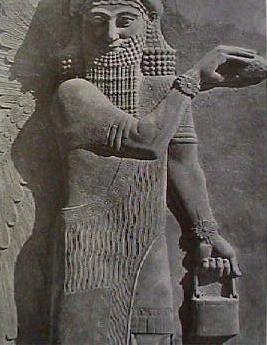
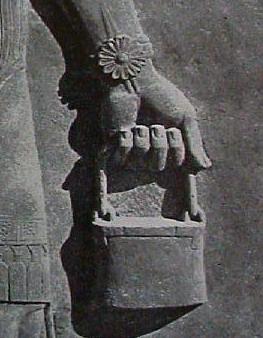
This depiction is from Khorsabad, 8th century BC.
Although the character in the image changes from one image
to another, an artistic significance is maintained over certain
specific features such as the bucket, the wristband and the 'cob'.
Cob or Pineal Gland.
It has been suggested
that the 'cob' object could be a pine-cone. The pine-cone has a
strong symbolism, being a reference to the 'Third-eye' or
'pineal-gland', so named because of its similarity in shape. The
pine-cone is traditionally associated with immortality and
knowledge. The Pineal gland is activated by Light, and it controls
the various biorhythms of the body. It works in harmony with the
hypothalamus gland, which directs the body's thirst, hunger, sexual
desire and the biological clock, that determines our aging process.
"E. A. Wallis Budge has noted that in some of the papyri illustrating the entrance of the souls of the dead into the judgment hall of Osiris the deceased person has a pine cone attached to the crown of his head. The Greek mystics also carried a symbolic staff, the upper end being in the form of a pine cone, which was called the thyrsus of Bacchus. In the human brain there is a tiny gland called the pineal body, which is the sacred eye of the ancients, and corresponds to the third eye of the Cyclops. " Manly P. Hall.

The Egyptian Staff of Osiris, dating back to approximately 1224 BC, depicts two intertwining serpents rising up to meet at a pinecone.
(Photo: Egyptian Museum, Turin, Italy)
Modern scholars and philosophers have noted the staff�s symbolic parallels to the Indian �Kundalini,� a spiritual energy in the body depicted as coiled serpents rising up from the base of the spine to the Third Eye (Pineal Gland) in the moment of enlightenment. Awakened Kundalini represents the merging and alignment of the Chakras, and is said to be the one and only way to attain the �Divine Wisdom� brining pure joy, pure knowledge and pure love.
In 1997, British Dr. Jennifer Luke extensively documented the Pineal Gland as the primary target for Fluoride accumulation in our bodies (5), where it calcifies the Pineal, inhibiting blood flow and �clogging� the basic functions of our Third Eye. By feeding the public Fluoride from birth, critics claim that our greater spiritual abilities are being dulled by chemically clouding our biological portal to spiritual awareness.
The Psychopharmacologist Rick Strassman believes the Third Eye/Pineal Gland to be the source of the psychedelic Dimethyltryptamine (DMT) in our bodies (6). Strassman has hypothesized that large amounts of DMT are released in our bodies during heightened states of spiritual consciousness, such as birth, death and near-death experiences -- or perhaps during the awakening of our Kundalini in a moment of Enlightenment.
Synthesized DMT, or plants containing DMT are often used as recreational psychedelics, or in shamanic ceremonies, such as the Ayahuasca ceremony originating in South America. DMT and/or Ayahuasca users often report intensely entheogenic experiences of spiritual awakening, contact with entities of supernatural or spiritual origin, and the dilation or compression of time.
(More about Drug-use in Prehistory)
The following image is from La Venta,
Mexico, in which we see a person
carrying a similar bucket.
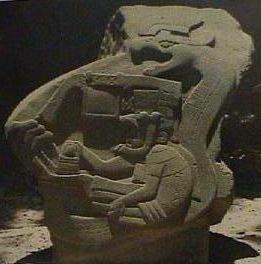
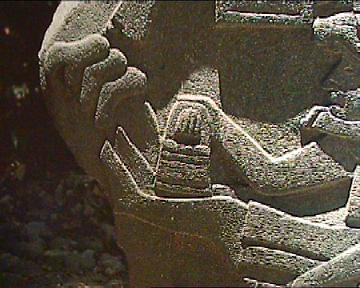
While this may well be a coincidence,
it is strongly suspected that the 'Olmec' culture at
La Venta was a multicultural colony from around 1,200 BC onwards. Several large
Negroid heads were carved there between 700 and 800 BC, suggesting
an African presence there at this time and there are several
real-life depictions of people with oriental features.
(More
about the Olmecs)

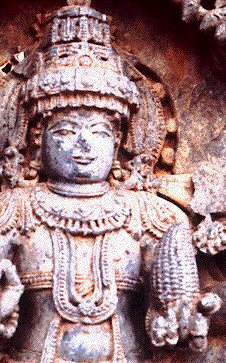

These images are from India. They
also appear to show images of 'Maize' or 'Corn', as the pattern does
not twist around the object in the way Pine cones do.
(More about Ancient
India) |
|




























 The
first cylinder seals belonged to the
now long dead civilization of the Sumerians,
the inhabitants of Nippur, Lagash, and other cities on the
Euphrates and Tigris rivers in what is now Iraq. They spoke
a strange language -- neither Semitic nor Indo-European, the
family of languages spoken by many later civilizations and
the most current inhabitants of the Middle East. Sumerian
was an tongue, bearing resemblance to such
diverse languages as Turkish, Finnish,
Japanese, and Dravidian. Indeed, it was probably some
version of the latter tongue that was spoken by their
neighbours, the early inhabitants of the Indus river valley.
These Indus valley people developed, soon after the
Sumerians, their own civilization and unique style of seals.
Modern speakers of Dravidian languages are scattered all
over the Indian subcontinent, including remnants in
Afghanistan and a large number of Tamils in southern India.
The
first cylinder seals belonged to the
now long dead civilization of the Sumerians,
the inhabitants of Nippur, Lagash, and other cities on the
Euphrates and Tigris rivers in what is now Iraq. They spoke
a strange language -- neither Semitic nor Indo-European, the
family of languages spoken by many later civilizations and
the most current inhabitants of the Middle East. Sumerian
was an tongue, bearing resemblance to such
diverse languages as Turkish, Finnish,
Japanese, and Dravidian. Indeed, it was probably some
version of the latter tongue that was spoken by their
neighbours, the early inhabitants of the Indus river valley.
These Indus valley people developed, soon after the
Sumerians, their own civilization and unique style of seals.
Modern speakers of Dravidian languages are scattered all
over the Indian subcontinent, including remnants in
Afghanistan and a large number of Tamils in southern India.  The Al-Gezeb Knife, Abydoss, Egypt
(right): This knife, with
the Gilgamesh figure carved on one side, was found in the
Pre-Dynastic cemetery at
The Al-Gezeb Knife, Abydoss, Egypt
(right): This knife, with
the Gilgamesh figure carved on one side, was found in the
Pre-Dynastic cemetery at 















